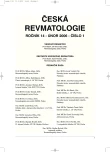-
Medical journals
- Career
The significance of Borrelia burgdorferi DNA investigation in a diagnostic algorithm of Lyme arthritis
Authors: H. Dejmková 1; I. Půtová 1; M. Paulík 2; Z. Mareš 1
Authors‘ workplace: Revmatologický ústav, Praha 1; Cytolab, Praha 2
Published in: Čes. Revmatol., 14, 2006, No. 1, p. 3-8.
Category: Overview Reports
Overview
Aims:
to evaluate sensitivity and specificity of Borrelia burgdorferi (B. burgdorferi) DNA detection in sera and synovial fluid from patients with Lyme arthritis (LA). To evaluate presence of B. burgdorferi DNA in serum and synovial fluid from patients with undifferentiated arthritis (UA).Methods:
we examined 102 serum and 37 synovial fluid samples from patients with various rheumatic diseases. First group consisted of 17 blood and serum samples and 9 synovial fluid samples from patients with definite diagnosis of LA. In the second group there were 13 blood and 10 synovial fluid samples from patients with UA. Third group consisted of 72 blood samples and 18 synovial fluids from patients with other established rheumatological diagnoses. DNA of B. burgdorferi was analyzed by PCR. Antibodies against B. burgdorferi were examined by ELISA and Western blotting. Sensitivity and specificity of the PCR B. burgdorferi DNA detection for the diagnosis of LA was calculated.Results:
We found B. burgdorferi DNA in the blood samples from 5 patients from the group of 17 patients with LA. Sensitivity of this examination was 29.4%. In the synovial fluid we demonstrated DNA in 4 of 9 patients, which corresponds to a sensitivity of 44.4%. There were no differences between positive plasmid and genomic DNA in LA patients (48% and 48%). Specificity of this examination was 40% for blood and 65% for synovial fluid. In the blood from group of 13 patients with UA we found B. burgdorferi DNA in 2 of them (15.4%). In the synovial fluid we demonstrated this DNA in 4 of 10 patients (40%). Abovementioned data showed no statistically significant difference between DNA in synovial fluid from patients with UA and LA (44% vs. 40%). In the blood from the group of 72 patients with other rheumatic diseases we found DNA in 13 patients (18.1%). In the synovial fluid we demonstrated DNA in 3 of 18 patients (16.7%). Presence of the B. burgdorferi DNA in synovial fluid from patients with UA was significantly higher in contrast to patients with other established rheumatic diagnosis (40% vs. 16.7%).Conclusion:
the evaluation of B. burgdorferi DNA in patients with LA showed low sensitivity in the blood (29.4%) and medium sensitivity in the synovial fluid (44.4%). Negative DNA finding does not exclude the diagnosis of LA. Specificity of this evaluation in the blood and synovial fluid is low (40% for blood and 65% for synovial fluid). Statistically insignificant difference between the presence of DNA in synovial fluid from patients with LA and UA (44.4% vs. 40%) revealed low value for this evaluation in differential diagnosis of these diseases. Low specificity of positive findings in the patients with LA in contrast to control groups showed also low implication of isolated DNA finding with regard to differential diagnosis of LA and other rheumatic diseases. Presence of B. burgdorferi DNA in the clinical sample represents only additional and not major diagnostic information when the analysis is performed in a general non-experimental laboratory.Key words:
Lyme arthritis, undifferentiated arthritis, B. burgdorferi DNA
Labels
Dermatology & STDs Paediatric rheumatology Rheumatology
Article was published inCzech Rheumatology

2006 Issue 1-
All articles in this issue
- The significance of Borrelia burgdorferi DNA investigation in a diagnostic algorithm of Lyme arthritis
- Modulation of bone turnover by glucocorticoid treatment
- Diffuse idiopathic skeletal hyperostosis (DISH) and ossification of posterior longitudinal ligament (OPLL) - metabolic and genetic factors
- Uncommon coincidence of Charcot osteoarthropathy with enteropathic arthritis
- Difficulties of differential diagnosis of brain alteration in a patient with systemic lupus erythematosus and secondary antiphospholipid syndrome
- Czech Rheumatology
- Journal archive
- Current issue
- Online only
- About the journal
Most read in this issue- Diffuse idiopathic skeletal hyperostosis (DISH) and ossification of posterior longitudinal ligament (OPLL) - metabolic and genetic factors
- Uncommon coincidence of Charcot osteoarthropathy with enteropathic arthritis
- The significance of Borrelia burgdorferi DNA investigation in a diagnostic algorithm of Lyme arthritis
- Modulation of bone turnover by glucocorticoid treatment
Login#ADS_BOTTOM_SCRIPTS#Forgotten passwordEnter the email address that you registered with. We will send you instructions on how to set a new password.
- Career

